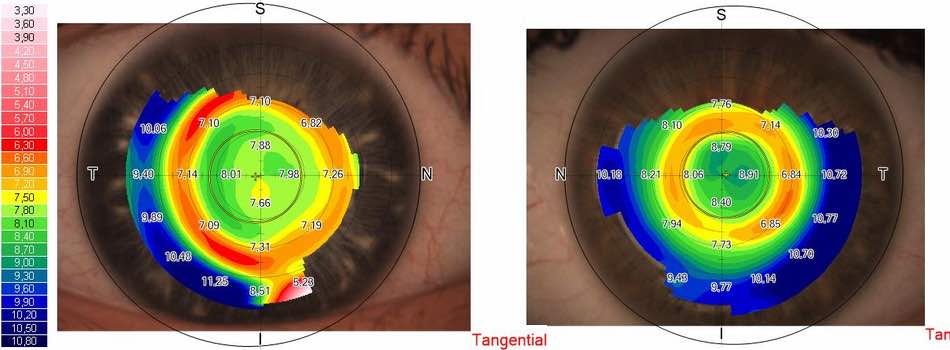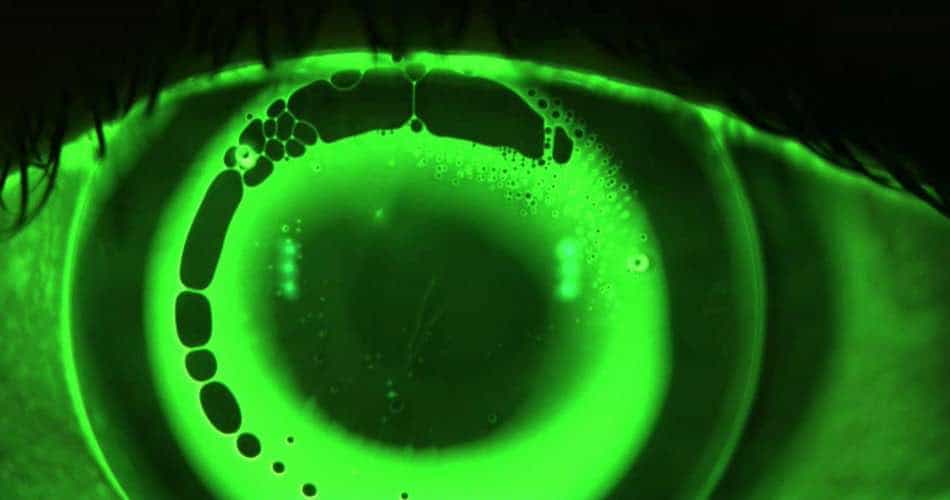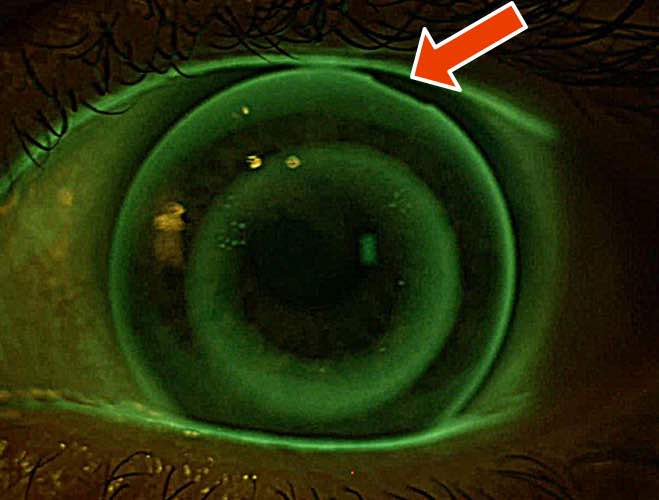This guide should be an easy-to-understand guide for troubleshooting Ortho K lenses. While Ortho K lenses are a great alternative to glasses and conventional contacts they also have their limitations. I wrote this article after I personally performed more than one hundred Ortho K fittings. So I saw problems during the fit when we started out fresh with Ortho K with my customers and those ones that came up after a few months where troubleshooting was necessary.
When it comes to troubleshooting Ortho K lenses the more information the optician or ophthalmologist collects the better. Things to discuss with him or her are:
- When do the problems occur?
- How stable are the problems?
- Can you trace back when exactly a certain problem came up?
- Did you change something around your sleeping routine?
pillows or timing - Do you have problems with allergies?
As you can see there can be a lot of things related to problems with Ortho K lenses. Depending on the combinations of your answers the troubleshooting techniques of your professional will vary. For example, let us discuss one of my favorite problems with Ortho K lenses which is seeing glare:
Ortho K Lenses Problems With Seeing Glare
This is a problem a lot of people experience. Things that can influence the glare are the following:
- high prescriptions
- big pupils
- bubbles under your lens during sleep
- decentered Ortho K lens on your cornea during sleep
- The wrong eye drops
- bad tear film quality
- staining
Most people indeed recognize glare when they enter a room that is not properly lit. So the problems do not appear outside in the daytime but inside or at night. The reason is the Ortho K lenses distribute your old prescription temporarily in a ring shape around your pupils. When the sun shines bright your pupils get smaller and the ring in front of your pupil is less disturbing to the light rays entering your eye.

When you enter a room with a less powerful lamp your pupils get bigger. Now the ring-shaped old prescription on your cornea will disturb the light rays entering your eyes more. This is the glare you see. To some people, it looks like a minimal blur and to others, the glare is extremely disturbing. In such a case the professional would first look at your eyes in general and the topography of your cornea.
With this information, the professional could see if the ring shape on your cornea produced by the ortho k lenses is centered nicely around the pupil or if they are decentered. When the ring shape is not centered correctly your old prescription will interfere with your vision. The glare may be seen even during the daytime. In such a case the lens design needs to be changed by the professional.
- The lenses can be ordered bigger for a better centration which reduces glare
- The lenses can be changed in regards to the periphery to produce a better alignment of the ortho lenses with your cornea.
With a good fit and still problems with glare bubbles under the Ortho K lenses during sleep are a common problem. The Ortho K lenses can only work properly when the tear film is distributed evenly under the lens. With a bubble, this is not the case and the prescription will probably not be corrected perfectly.
It is the duty of the professional to make sure the wearer notices bubbles under the lens. For some wearers, it is sufficient to only look in the mirror while some need to add a bright light or a magnifying glass to see the bubbles. But I advise you to check for bubbles every time before you go to sleep. In order to get rid of the bubbles, some wearers of ortho K lenses need to improve the way they put on the lenses while others need to use more saline while they put the lenses on.

While a decentered lens produces glare everyday bubbles will produce glare here and there with a change in its intensity depending on how big the bubbles were. In the list above I mentioned bad tear film quality as a reason for glare. This is something your professional can improve to an extend with dry eye treatment you can learn more about it here. Dry eyes for example can lead to deposits on your ortho k lenses which could produce a sort of impression on your cornea which again leads to glare.
This is why your professional checks the Ortho k lenses too to see if adjustments need to be made to the cleaning routines in regards to more rubbing of the lenses (but be careful, they can break) or to the cleaning solution.
The last solution to reduce glare is medication. There is the possibility to use eye drops to make the pupils smaller. In such a case the ring shape on your cornea would be less disturbing especially when you have a very large diameter of your pupils or when you have a high prescription (More than 5D). I am not a fan of this method but it is a way to reduce the glare.
When it comes to staining the Ortho K lenses have too much contact and impair the cells in this special place. This place is usually directly in the middle of your cornea. Because this place is very much directly in front of your pupil visual drawbacks such as glare are described by the wearer of Ortho K lenses. Your optician or ophthalmologist checks for staining with yellow contrast dye.
In combination with blue light and a filter in the slitlamp (microscope), the damaged cells show up. Of course, this is not ideal and the shape of the contact lens needs to be changed in order to not impair the cells on the cornea of the wearer. When we talk about changes one of the radii of the Ortho K lens is changed (usually in 0.02mm increments). The distance can be increased or decreased between the lens back surface and the cornea.
Even small increments can lead to big changes. But do not expect to get rid of all the glare. This is simply common with most Ortho K wearers some notice it and others are not sensitive to those changes in their vision. Speaking of small changes when it comes to glare in some cases with the wrong eyedrops the glare can increase on the next day. The reason for the increased glare is when the eye drops are too thick when it comes to their consistency they can keep the Ortho K lenses from producing the correct shape of your cornea.
So when the glare increased spontaneously try to think about the eye drops you wear using before you went to bed. Sometimes it is not the consistency but some ingredient that makes your tear film quality worse. Try to use only those ones without preservatives. The same is true for the saline you fill in the contact lenses before placing them on your eyes.
Why Are the Ortho K Lenses Not Working?
Orthokeratology is an effective and safe modality to correct moderate myopia for most people. But there is also a very small number of people where Ortho K lenses simply will not work.
Among my 100 Ortho K fits in my shop I met two persons where orthokeratology did not lead to the desired effect. We optimized the lenses looked back at our base measurements and tried to find an error in the measurements. But they did not respond well to the Ortho K fits.
They never were able to get rid of daily contacts. Among the one hundred, Ortho K fittings were approximately 20% slow responders but they still had great results in the end. Normally when I have a customer with 4 diopters of myopia I tell them it will take up to three weeks until we have a really stable result. For slow responders, Ortho K fits can take up to three times as long. So hang in there and stick to the plan. Chances are you might get to a great result too in the end.
Why Do the Ortho K Lenses Not Produce a Lasting Effect?
Ortho K lenses do not produce a lasting effect because they work by compressing and expanding cells on the outer part of your cornea. Those cells tend to revert to their original shape. As soon you put the ortho k lenses off they start to revert very slowly. This is why the effect lasts approximately one day until you need to wear them again.
Researchers try to produce longer-lasting effects with Ortho K fittings. But for now, they failed to do so.
Problems With Blurry Vision
Blurry vision with Ortho K lenses is a problem, especially during the setup phase. In this time the wearer of the ortho K lenses should benefit from incremental visual improvement day by day. However, the nature of the Ortho K fit is to reshape the cornea. This process leads oftentimes to irregularities of the cornea. The effect is oftentimes a great visual acuity like 20/20 vision but for some wearers, this perceived visual experience is still blurry.
What those wearers oftentimes perceive is an increase of aberration which always comes in combination with the reshaping of the cornea. When the wearers are not accustomed to those aberrations (spherical) they can be irritated. Because they thought about the same clarity and contrast of the visual experience they have with glasses or conventional contacts which is not the case with Ortho K fittings.
When the best outcome is not satisfying for the wearer an attempt could be made to increase the size of the optic zone central to the ortho k fit. But oftentimes this leads to instabilities and the recommendations in regards to the lab that manufacturers the lenses should be followed.
Ortho K Lenses and the Problems With Double Vision
Double vision with ortho K lenses can be traced back to the following two reasons.
- Uncorrected Asigmatism
- Double vision due to a imbalace in the eye muscles
When double vision is present even when the other eye is closed uncorrected astigmatism is the problem. This usually causes something like a shadow effect from the actual image. In such a case things can appear twice. The stronger the correction needs to be for astigmatism the more the images are apart. At night this leads to starbursts. These days astigmatism to an extend can be corrected with special ortho K lens designs like with the FOK IT from Falco Linsen AG.
When it comes to double vision which is only present when both eyes are open at the same time the eye muscles need to be checked. In such a case prisms could be the solution to the problem which can only be corrected with glasses or by surgery.
What to Do When Your Ortho K Lens Is Broken?
Do not try to wear a broken Ortho K lens as it could lead to damage to your eye. In case of a broken Ortho K lens call your eye care professional and order a new lens.

If you want to learn more about the experience of a professional with Ortho K lenses I have another article here ready for you.
